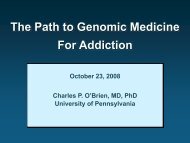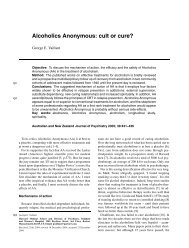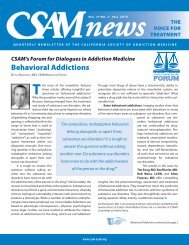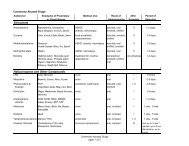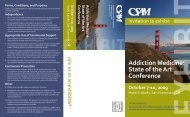SAN FRANCISCOMEDICINE - California Society of Addiction ...
SAN FRANCISCOMEDICINE - California Society of Addiction ...
SAN FRANCISCOMEDICINE - California Society of Addiction ...
Create successful ePaper yourself
Turn your PDF publications into a flip-book with our unique Google optimized e-Paper software.
decriminalized.<br />
The Narcotics Addict Rehabilitation<br />
Act <strong>of</strong> 1966 authorized programs and<br />
grants to private organizations as well as<br />
individual states for an alternative civil<br />
process <strong>of</strong> addiction treatment and for<br />
rehabilitation for some federal prisoners.<br />
The Office <strong>of</strong> Economic Opportunity<br />
funded multimodality, community-based<br />
drug and alcohol treatment, and methadone<br />
maintenance for heroin addicts<br />
gradually gained acceptance.<br />
In 1970, federal drug law and police<br />
power were strengthened by passage<br />
<strong>of</strong> the Controlled Substance Act, a subtitle<br />
<strong>of</strong> the Comprehensive Drug Abuse<br />
Prevention and Control Act. The Act<br />
also, in a compromise with moderate<br />
views, authorized treatment and rehabilitation<br />
services, eliminated mandatory<br />
minimum sentencing, and raised levels <strong>of</strong><br />
funding for research and for the prevention<br />
<strong>of</strong> abuse and dependence. At this<br />
time, treatment <strong>of</strong> drug abuse received<br />
more funding than did law enforcement.<br />
Federal assistance to states with prevention<br />
programs and interventions had a<br />
positive effect: The rate <strong>of</strong> the increase<br />
<strong>of</strong> drug abuse was slowed. The urgency<br />
surrounding these issues motivated<br />
Congress to establish the National Institute<br />
on Drug Abuse (NIDA), under the<br />
auspices <strong>of</strong> the NIMH, in 1972.<br />
During the 1980s, military spending<br />
on the “War on Drugs” was substantially<br />
increased. Mandatory minimum sentencing<br />
was reinstated, ostensibly to<br />
punish major drug dealers. The policy<br />
actually resulted in heavy sentences for<br />
many impoverished addicts and people<br />
in the periphery <strong>of</strong> the drug trade, and it<br />
fostered the rapid growth <strong>of</strong> a privatized,<br />
for-pr<strong>of</strong>it prison system. Federal support<br />
for social programs diminished; most <strong>of</strong><br />
the responsibility for funding prevention<br />
and treatment programs was transferred<br />
to the states; and various stakeholders,<br />
including university researchers, addiction<br />
specialists, treatment providers,<br />
state administrators, and community<br />
groups, found it vital to intensify their<br />
collaboration—with good results.<br />
In 1992 the Substance Abuse Mental<br />
Health Services Administration (SAMH-<br />
SA) was established, with Centers for<br />
Mental Health Services (CMHS), Substance<br />
Abuse Prevention (CSAP), and Substance<br />
Abuse Treatment (CSAT). Federal<br />
drug, alcohol, and mental health research<br />
institutes were integrated into NIH and<br />
separate authorization was made for the<br />
NIDA Medication Development Program<br />
and for the establishment <strong>of</strong> National<br />
Drug Abuse Research Centers. Subsequently,<br />
a major program <strong>of</strong> research<br />
was expanded at the NIDA Behavioral<br />
Therapies Development Program.<br />
From 2001 to 2009 there was a 50<br />
percent increase in federal funding for<br />
supply reduction (interdiction <strong>of</strong> drugs,<br />
source-country programs, and law enforcement).<br />
There also was increased<br />
collaboration between government<br />
and the private sector in the fields <strong>of</strong><br />
education, prevention, and treatment;<br />
and significant progress was made in<br />
translating research into effective practice.<br />
As addiction expert Darryl Inaba<br />
unequivocally stated in 2008, “Treatment<br />
Works! Outcome studies like CALDATA,<br />
CalTOP, and DATOS document positive<br />
treatment outcomes for drug and alcohol<br />
addiction, including methamphetamines.”<br />
The recognition that it is important to<br />
engage with the community <strong>of</strong> addicts to<br />
design services that encompass a broad<br />
spectrum (including health, housing,<br />
vocational issues, transportation, and<br />
legal and social connections) and most<br />
effectively meet their needs has contributed<br />
to the implementation <strong>of</strong> integrated<br />
services and recovery-oriented programs<br />
that help sustain individual wellness and<br />
healthy communities.<br />
When the Obama administration<br />
took <strong>of</strong>fice in 2009, it expressed support<br />
for giving priority to incorporating<br />
public health solutions in federal drug<br />
policy, including drug abuse treatment<br />
services in national health care reform,<br />
expanding programs for prevention and<br />
effective treatment (taking into account<br />
the disease model <strong>of</strong> addiction and<br />
considerations <strong>of</strong> chronic care), and continuing<br />
progress on providing recovery<br />
opportunities for addicts in the criminal<br />
justice system.<br />
Insurance parity for mental health<br />
and addiction is now law, and the controversial<br />
Patient Protection and Affordable<br />
Care Act has passed. Ahead lie ethical<br />
and practical challenges for the medical<br />
pr<strong>of</strong>ession. A few <strong>of</strong> the many questions<br />
that come to mind:<br />
Will the current relative scarcity <strong>of</strong><br />
specialists affect the inclusion <strong>of</strong> appropriate<br />
addiction services<br />
Is there sufficient commitment to<br />
medical education in substance abuse<br />
Will administration and bureaucracy<br />
complicate rather than facilitate access<br />
to care<br />
Does the removal <strong>of</strong> barriers to reimbursement,<br />
created in the 1950s by state<br />
insurance laws, ensure that appropriate<br />
screening for substance abuse disorders<br />
in emergency departments will no longer<br />
be neglected, or are new guidelines<br />
needed<br />
How will resources be prioritized<br />
Preliminary findings from recent<br />
studies indicate that adolescence marks<br />
the onset <strong>of</strong> primary mental health disorders,<br />
with substance use disorders<br />
occurring some five to ten years later, during<br />
late adolescence and early adulthood.<br />
Now there is the opportunity to provide<br />
a full spectrum <strong>of</strong> health care for more<br />
young people. What do health reform and<br />
parity regulations <strong>of</strong>fer neglected populations—those<br />
suffering the poorest health,<br />
including the homeless, prisoners, and<br />
war veterans<br />
The opportunity for medical leadership<br />
is clear. Will the pr<strong>of</strong>ession rise to<br />
the occasion, or will the punitive policies<br />
<strong>of</strong> the past 100 years prevail<br />
Philip R. Lee, MD, is pr<strong>of</strong>essor <strong>of</strong> social<br />
medicine, senior advisor, and chancellor<br />
(emeritus) <strong>of</strong> the Department <strong>of</strong> Medicine,<br />
Philip R. Lee Institute for Health Policy<br />
Studies, School <strong>of</strong> Medicine, U.C. San Francisco;<br />
pr<strong>of</strong>essor emeritus at Stanford; and a<br />
former United States Assistant Secretary <strong>of</strong><br />
Health. Dorothy Lee is a freelance research<br />
assistant, editor, and translator based in<br />
Athens, Greece.<br />
www.sfms.org June 2010 San Francisco Medicine 13




